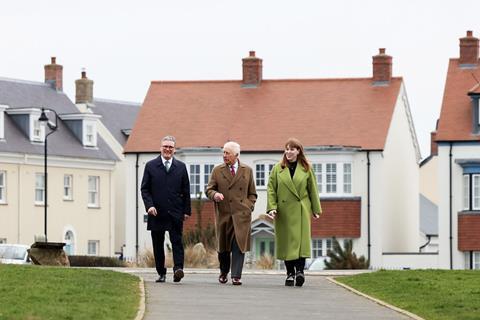Experts also urge multi-decade public lending
The government’s affordability targets for new towns could put delivery at risk, according to evidence given to a House of Lords Committee.
New towns, defined by the government as settlements of 10,000 homes or more, form a major part of the government’s ambition to ramp up housebuilding in the UK.

The government’s new towns taskforce is set to name around 12 sites for planned new towns this summer. The New Towns Code, which sets out requirements for the schemes, says that the new wave of settlements will aim for 40% affordable housing, with a focus on social rent.
Yesterday (Tuesday), the House of Lords built environment committee heard evidence from property and development sector experts on how the new town policy should be delivered.
Charlotte Neal, director of professional practice and research at Royal Institution of Chartered Surveyors, questioned whether 40% was “the right amount of affordable”, adding that supply constraints were making viability “really challenging”.
“We’ve got material costs, construction cost inflation, and actually, if it then makes a site unviable, you get nothing delivered, whereas if you reduce that affordable amount, then it might make something viable, and therefore you at least get delivery,” she said.
She suggested that a system for offsetting affordability requirements in different parts of the country could be effective.
“In some areas you could possibly offset where they don’t need quite so much to somewhere that needs more and try and somehow balance that across,” she added.
Caroline Foster, development director at Urban & Civic, said housing associations specifically would find the target “difficult” to take currently.
“We know that 10%, 20%, 25% is do-able under the Homes England loans,” she said. “If you start to say it’s 40%, then absolutely it will need additional funding and additional support in a variety of ways.”
Neal added: “We need to be careful about getting rather than just putting a blank blanket amount on, really looking at what does make it viable for private sector to get behind, because there are lots of other options, particularly if you’re a pension fund or an institution investor, where you can deploy capital, and so we have to make this an attractive prospect for them.”
Melanie Leech, chief executive at the British Property Federation, said there was a recognition in the industry that public sector funding would not be available on the same scale as in previous generations of new town development.
However, she also said she did not think the private sector could “wholly fund” the plans, urging a partnership approach and for the public sector to pick private sector partners “carefully”, looking for the “kinds of investors that have that long-term patient outlook”.
>> Read more: London green belt development could include new towns, Sadiq Khan confirms
Going through some of the funding options available to the government, she said her “preference” was that lending for new towns should be “multi-decade” and secured against the land and the buildings so it could be classified as investment in an asset rather than as a loan.
She also alluded to a report by the Pension Insurance Corporation on ‘regeneration leases’, under which a public sector body gets upfront capital from private sector investors, and repay it over time through the income arising from the homes and the workplaces and so on that are built.
Leech also wondered if there could be an extension of models currently used to fund infrastructure, suggesting the government could “create mechanisms whereby the private sector could be repaid for more than just the infrastructure through some kind of additional Levy, whether that’s on community assets or whether that’s on as part of the business rates surcharge or something like that”.
The independent new towns taskforce, which is being led by Sir Michael Lyons and Dame Kate Barker, has been examining proposals for more than 100 sites ahead of its decision this summer.
Earlier this year, housing minister Matthew Pennycook said construction on new towns would begin within the next four years.
The government is expected to set out design principles favouring traditional, Georgian-style homes and winding streets in an effort to create “well-designed, beautiful communities”.



























No comments yet